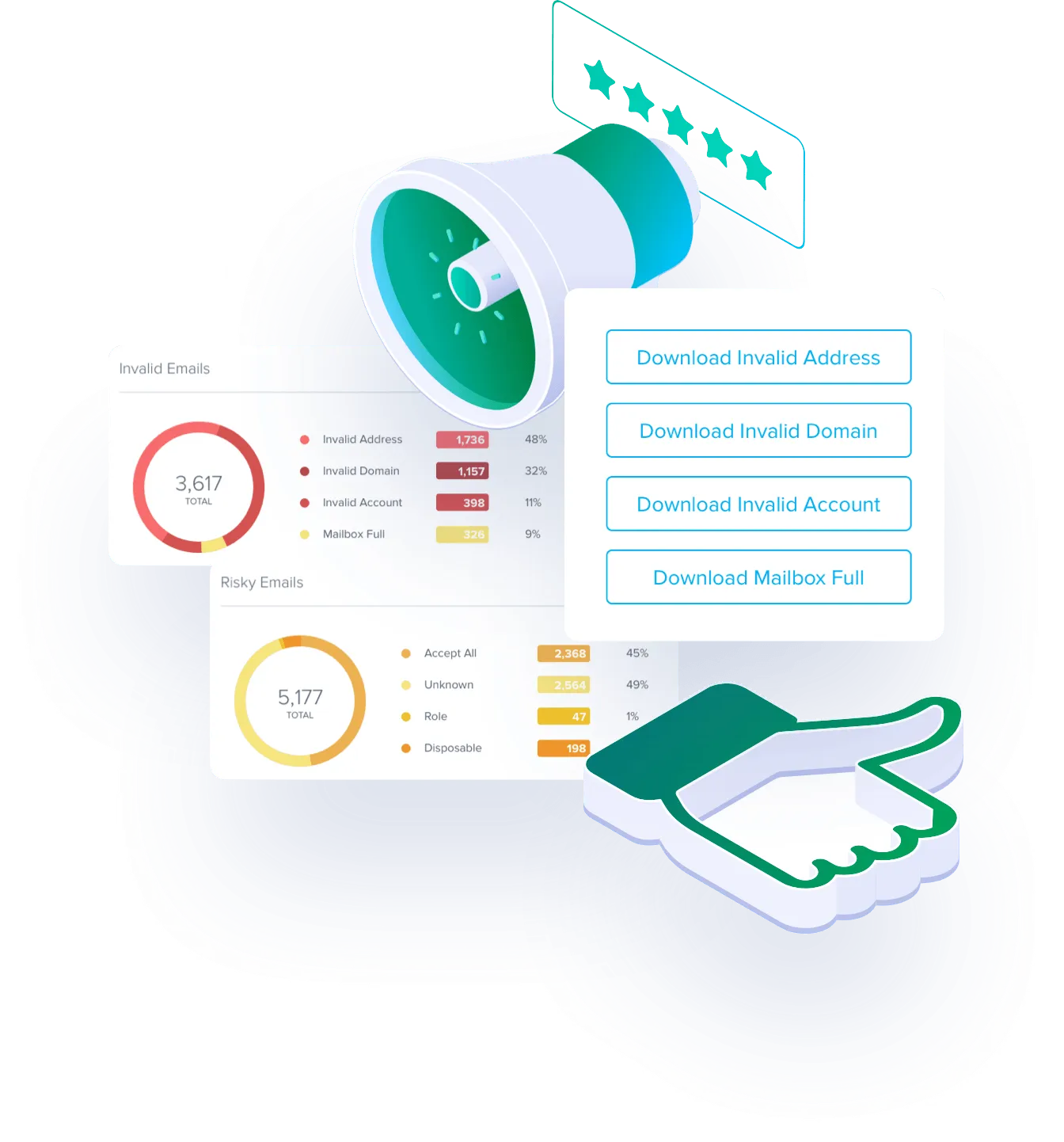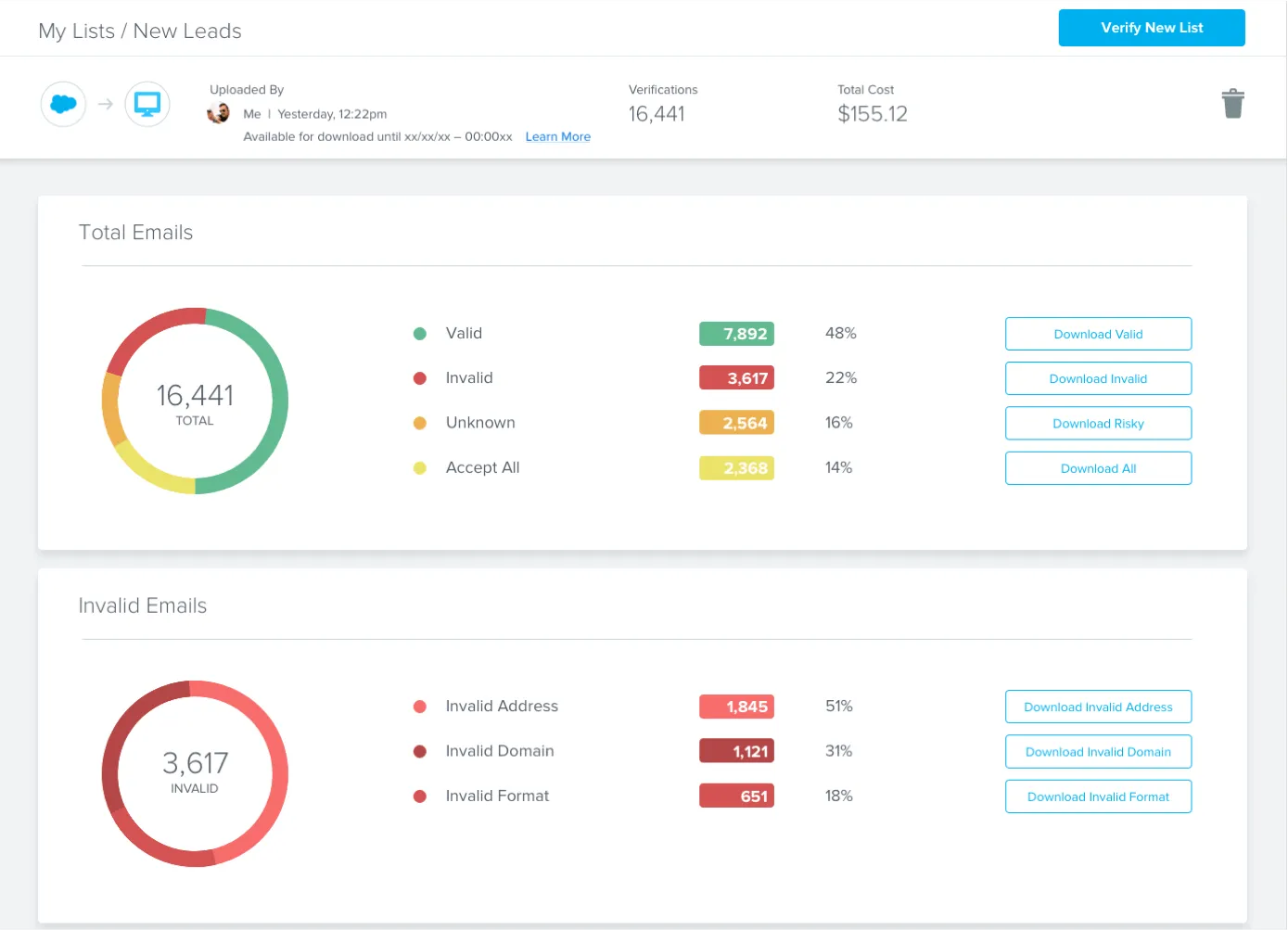New integration available with Iterable. Make your Journey workflows smarter and keep your database clean.
BriteVerify®—Your Premier Contact Verification Tool for Address, Phone, and Email Validation
Validity® BriteVerify® is the industry’s longest-standing contact verification solution providing secure, scalable validation so you can build and maintain an actionable database, reach more people, and communicate more effectively.

Trusted by thousands of marketers and CRM professionals.
Improve the experience for your customers and internal teams.
Build and maintain a clean and actionable database.
Prevent bad data from entering your database and keep it actionable.
Reach and engage more people.
Protect your sender reputation by reducing your bounce rate so you can connect with more people.
Communicate more effectively.
Focus your sales, marketing, and customer service efforts on real opportunities and customers.
Build and maintain a clean and actionable database.
Databases are filled with invalid and unactionable contact data that destroys your sender reputation, hinders email engagement, and wastes valuable resources. Data can be invalid from the start, as fake or misspelled information is submitted on your web forms every day. Plus, a portion of your customer data will decay every year, as contact information does not remain actionable permanently. Maintaining a clean database is no easy task.
BriteVerify allows you to prevent bad data from entering your database in the first place. It keeps data actionable, improving the experience for your customers and internal teams who rely on accurate data to do their jobs. A clean contact database can improve team efficiency, enhance customer relations, and make verifying email addresses and sending emails more manageable.

Maintain a clean database your teams can trust.
Validate contact information in real time at the point of capture to prevent invalid data from entering your database.
Perform bulk validation of your stored data to identify email addresses that have changed, become disabled, or no longer exist so you can remove them from your campaigns.
Check your database’s phone numbers and mailing addresses to ensure you are contacting real people and not wasting money mailing to erroneous addresses.

“BriteVerify has been an integral part of our platforms. Since using this on the Club Individual app a number of years back, we took the stance to verify any email address in our customer’s platforms using BriteVerify. We now include this as standard. It’s been a great tool to provide others with guaranteed clean data and has stopped errors and the associated helpdesk calls from customers not receiving their welcome emails.”
Adam Purslow, IT Director
The Loyalty Co.

Reach and engage more people with accurate email validation.
An email address is one of the most valuable assets of your digital marketing program. However, faulty addresses can be detrimental to your success. Mailing to invalid or problematic email addresses damages your reputation with mailbox providers. With a poor sender reputation, more of your messages land in the spam folder, preventing you from reaching and connecting with legitimate recipients.
BriteVerify makes verifying valid emails more accurate and efficient. The email validation tool rapidly checks the status of each email address and recommends how to treat it, allowing you to remove faulty addresses before you mail to them. With BriteVerify, you can protect your sender reputation by reducing your bounce rate, enabling you to reach and engage more people.
Protect sender reputation and improve deliverability.
Use the BriteVerify web app’s quick, simple, and secure list validation to identify the status of each address on your list before you send a campaign.
Perform email verification at speed and scale to identify invalid addresses before they impact your reputation and email engagement.
Combine list validation and Everest, Validity’s all-in-one email success platform, to truly maximize your email deliverability.
“In four months, we implemented programs to catch invalid emails and saw our unknown user rate drop from 1-6% to below a tenth of a percent. Our open rates increased over 100% from 20.1% to 50.3%.”
Marketing Automation Manager
PODS
Secure and accurate address, phone, and email validation you can trust.
Feel confident in the security and accuracy of your verification results when you work with BriteVerify. With over a decade of experience in the validation space, we’ve honed and perfected our security to protect the privacy of our customers and their subscribers. We continue to evolve our offerings with ethical data management at the core, which is why the biggest global brands trust us to get the job done.
Communicate more effectively with verified contact info.
Unverified data increases wasteful marketing spend, slows down sales follow-up, and adds friction to the customer journey by hindering timely and personalized communications. Sales and marketing teams waste significant time and money using bad data. With BriteVerify, you can ensure your contact data is valid.
The email validation software eliminates the time and money spent communicating with fake people and dormant contacts. Plus, verified data allows you to deliver the best possible experience for your customers with personalized messages and on-time follow-up. BriteVerify allows your sales, marketing, and customer service teams to leverage verified contacts and focus their efforts on creating more opportunities with customers to drive revenue.

Market, sell, and service more effectively:
Validate information at the point of entry to improve the experience for your customers and internal teams.
Perform bulk verification to ensure contact information is continuously actionable for sales, marketing, and customer service communications.
Integrate with your existing platforms to save time and continue working out of the systems your teams know and love.
Use bulk email validation within DemandTools to validate Lead and Contact email addresses directly in your CRM.

Gail Buffington, Director of eCommerce
Soft Surroundings
Integrate with your existing email marketing tools.
BriteVerify offers ready-made integrations with major marketing platforms and enables custom integrations with major email service providers (ESPs) and CRMs through our API suite. Save time by verifying new or existing contact information and exporting results directly to your existing platform. The simple integration process helps streamline your email marketing strategies, making it easier for large email sends to reach your target audience.
Comprehensive data management and deliverability solutions.
BriteVerify is more than your standard contact validation tool. It offers solutions that grow and scale with your business. It integrates directly with other industry-leading Validity products, including Everest and DemandTools, providing complete email marketing and data management solutions that solve your biggest pain points and generate more revenue.
The holistic data management approach improves a sender’s reputation and deliverability. This tool’s myriad of benefits can enhance your team’s efforts to connect with customers while using the products they already know. Manage the emails, addresses, and phone numbers you receive from prospective and existing customers to keep everything organized and send communications in an orderly way.
Why choose BriteVerify?
BriteVerify is the industry’s longest-standing email and contact verification solution. With over a decade of experience and expertise, we have paved the way for email verification software. That’s why thousands of organizations, big and small, trust BriteVerify to provide validation at the pace and scale of their business.
With BriteVerify, you have a comprehensive solution for your contact validation needs. From cleaning and maintaining databases to verifying valid email addresses and improving deliverability, BriteVerify offers the tools you need to serve your customers best. Connect the email validation software to your existing platforms for seamless integration of products. You can streamline your validation and verification workflow by connecting all your platforms.

Reach legitimate customers with BriteVerify’s contact and email validation capabilities.
Want to chat? Schedule a time with one of our experts to discuss how to maintain an actionable database and reach more people.
